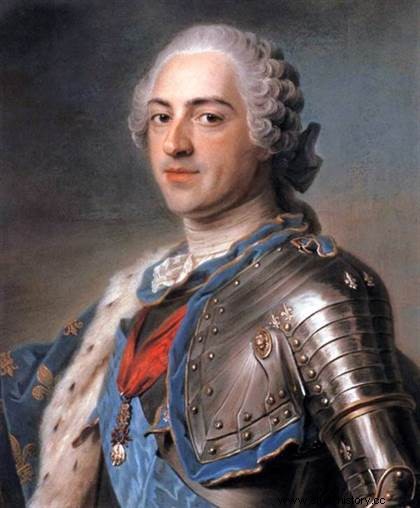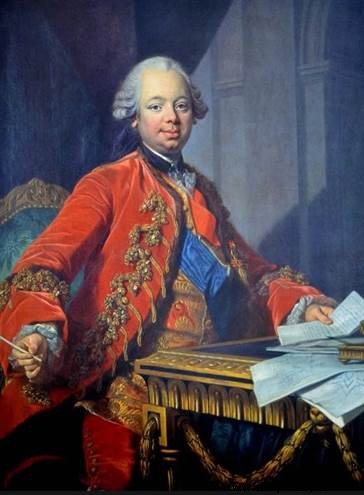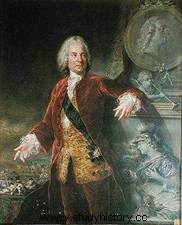 Lyes XV (1710-1774) was King of France from 1715 to 1774. Great-grandson of Louis XIV, he succeeded him on the throne when he was only five years old:power was then entrusted to the regent Philippe d Orleans until 1723. Well advised by Cardinal Fleury, the young monarch aroused hope and enthusiasm in the kingdom at the start of his reign and earned the nickname of “Beloved”. A few decades later, the atmosphere is very different. Loss of Canada, Louisiana and India following the disastrous Seven Years' War, expensive parties, influence of his mistresses, reforms too timid or too late... reproaches are legion. With an indecisive character, Louis XV proved incapable of promoting the reforms necessary to modernize the country and respond to the new aspirations of his subjects. Royal absolutism is in crisis and the seeds of the French Revolution are planted.
Lyes XV (1710-1774) was King of France from 1715 to 1774. Great-grandson of Louis XIV, he succeeded him on the throne when he was only five years old:power was then entrusted to the regent Philippe d Orleans until 1723. Well advised by Cardinal Fleury, the young monarch aroused hope and enthusiasm in the kingdom at the start of his reign and earned the nickname of “Beloved”. A few decades later, the atmosphere is very different. Loss of Canada, Louisiana and India following the disastrous Seven Years' War, expensive parties, influence of his mistresses, reforms too timid or too late... reproaches are legion. With an indecisive character, Louis XV proved incapable of promoting the reforms necessary to modernize the country and respond to the new aspirations of his subjects. Royal absolutism is in crisis and the seeds of the French Revolution are planted.
Louis XV the Beloved
Born in Versailles on February 15, 1710, the future Louis XV was the great-grandson of Louis XIV and the son of the Duke of Burgundy. Became king on September 1, 1715, he was installed in the Tuileries in 1716 during the regency of Philippe d'Orléans. He was entrusted to the good care of Madame de Ventadour and Marshal de Villeroy, as well as to Cardinal de Fleury, to whom Louis owed his excellent education and an interest in science and technology, which he would encourage during his reign.  Louis XV came of age in 1723 the year the Duke of Orléans died.
Louis XV came of age in 1723 the year the Duke of Orléans died.
Married to Marie Leszczynska, daughter of the King of Poland, in 1725, he left responsibility for affairs to Cardinal Fleury, his tutor, for a long time. This period is the most prosperous of the reign. Resisting the opposition of the Parliament of Paris and the Jansenists, Fleury strives to restore the balance of public finances, promoting the development of the economy and colonial trade (Atlantic slave trade, triangular trade).
Pacifist, he pursues a policy of peace abroad. but allowed himself to be drawn into the War of the Polish Succession (1723-1738) to support the king's father-in-law, Stanislas Leszczynski. The Treaty of Vienna (1738) put an end to the conflict and the Duchy of Lorraine was bequeathed to France on the death of Stanislas in 1766. Then, in 1740, the War of the Austrian Succession broke out, which was marked by the useless victory of Fontenoy (1745) and which ends in 1748 by peace without winner of Aix-la-Chapelle. Louis XV was long criticized for having “worked for the King of Prussia”, his ally and sole beneficiary of the conflict.

The Pompadour co-regency
The death of Fleury in 1743 led Louis XV to take a greater interest in the conduct of the kingdom:he announced his intention to govern personally and did not appoint a prime minister. With a fragile and self-effacing personality, he quickly came under the influence of his many favourites, in particular that of the Duchess of Châteauroux and the Marquise de Pompadour, of bourgeois origin.
The latter, beautiful, intelligent and cultivated, was a woman of power, a friend of encyclopaedists and a regular at the salons of the Age of Enlightenment. For nearly twenty years, the Pompadour acted like a true sovereign:she made and unmade ministers, advised ambassadors, reversed alliances, corresponded with the military. His initiatives are far from successful and his influence with the king is mainly content to flatter the monarch's weaknesses.
 France then experienced a period of internal divisions, caused by the opposition of parliament to the king's fiscal policy (who wants to make the privileged pay to provide new revenue for the state) and his religious policy. In addition, several ministers want to keep Madame de Pompadour away and prevent France from going too far alongside Austria in a new European war.
France then experienced a period of internal divisions, caused by the opposition of parliament to the king's fiscal policy (who wants to make the privileged pay to provide new revenue for the state) and his religious policy. In addition, several ministers want to keep Madame de Pompadour away and prevent France from going too far alongside Austria in a new European war.
A symbol of the monarch's growing unpopularity, the king is the target of an attack without consequence that leaves the kingdom indifferent. On February 5, 1757, the son of a family of ruined farmers, Robert François Damiens, wanting to remind the king of his duties towards his subjects, struck Louis XV with a penknife. Condemned as a regicide, he suffered harsh torture:his hand was burned with molten lead and was quartered on the Place de Grève.
The Disastrous Seven Years' War
The colonial rivalries between France and England were such that, in 1755, the English boarded several hundred French merchant ships and allied themselves in 1756 with Prussia in Frederick II, while Louis XV signed the same year with Marie-Thérèse of Austria the Treaty of Versailles. This is the beginning of the Seven Years' War which will take place on two fronts:in the Holy Empire and overseas.
In Germany, after the invasion of Saxony by Frederick II and the alliance of France and Austria with Russia and Sweden, the Prussians were driven out of Bohemia, beaten at Kloster Zeven, then victorious at Rossbach and Leuthen (1757). Then, in 1759, the Russians crushed the Prussian army at Kunersdorf and occupied Berlin in 1760. But the accession of Tsar Peter III led to the signing in 1762 of a separate peace between Russia and Prussia.
 France then got bogged down in a conflict that went very badly, especially since, in the second theater of he operations, the French troops suffered defeat after defeat:after having recaptured Menorca, invaded by the French, the English fleet cut France off from its colonies. In Canada, Montcalm, who lost the Saint-Laurent valley, then Quebec, was killed at the battle of Abraham (1759); Montreal surrenders (1760). In India, Dupleix, governor of Chandemagor, previously consolidated French positions with local princes by exchanging military protection for commercial privileges granted to the Compagnie des Indes. He first fought effectively against the English, the fleet of La Bourdonnais succeeding in seizing Madras in 1746; but Dupleix was recalled in 1754, and the French troops commanded by Thomas Lally, Baron de Tollendal, in difficulty, were forced to capitulate at Pondicherry (1762).
France then got bogged down in a conflict that went very badly, especially since, in the second theater of he operations, the French troops suffered defeat after defeat:after having recaptured Menorca, invaded by the French, the English fleet cut France off from its colonies. In Canada, Montcalm, who lost the Saint-Laurent valley, then Quebec, was killed at the battle of Abraham (1759); Montreal surrenders (1760). In India, Dupleix, governor of Chandemagor, previously consolidated French positions with local princes by exchanging military protection for commercial privileges granted to the Compagnie des Indes. He first fought effectively against the English, the fleet of La Bourdonnais succeeding in seizing Madras in 1746; but Dupleix was recalled in 1754, and the French troops commanded by Thomas Lally, Baron de Tollendal, in difficulty, were forced to capitulate at Pondicherry (1762).
Finally, while France tries to rely on Spain, England occupies Florida and Cuba. You have to resign yourself to dealing. By the Treaty of Paris (February 1763), France left England Canada, part of Louisiana and the West Indies, its possessions in Senegal, and compensated Spain by ceding the rest of Louisiana.
France keeps Martinique, Guadeloupe and Saint-Domingue, but only keeps five defenseless trading posts in India (Pondicherry, Chandemagor, Karikal, Mahé and Yanaon). The English now have a free hand in America and India, while in France the elites are unaware of the long-term consequences of these catastrophic losses.
A difficult end of reign
After the successive deaths of the Marquise de Pompadour (1764) - who would be replaced by the Comtesse du Barry -, the Dauphin (1765) and the Queen (1768), Louis XV, isolated, had to face a double opposition:that of the privileged classes, hostile to tax reforms, and that of the Jansenists, allied to the Gallican parliamentarians (for an autonomy of the Church of France in relation to Rome), fighting against the Roman party (Catholics who claim the total submission of the Church to the Pope) and denouncing royal absolutism.
 In 1661, the arrival in business of the Duke of Choiseul, who was to remain in power until 1770, corresponds to a relative improvement. Linked with the philosophers, protector of the Encyclopedia, fairly well regarded by parliamentary circles, Choiseul endeavored to carry out a series of far-reaching reforms, particularly within the navy and the army, and bought Corsica by France, even if he was unable to prevent the second partition of Poland.
In 1661, the arrival in business of the Duke of Choiseul, who was to remain in power until 1770, corresponds to a relative improvement. Linked with the philosophers, protector of the Encyclopedia, fairly well regarded by parliamentary circles, Choiseul endeavored to carry out a series of far-reaching reforms, particularly within the navy and the army, and bought Corsica by France, even if he was unable to prevent the second partition of Poland.
Fairly ambiguous in his choices, Choiseul nevertheless allowed the rebellion to develop against the royal power and his benevolence towards parliamentarians (he endorsed the banishment of the Jesuits from the kingdom in 1767 of France) ended up increasing the arrogance of this real counter-power in a disproportionate way. When Choiseul left, dismissed in 1770, partly for having displeased the king's new mistress, Madame du Barry, the parliamentary crisis was more topical than ever.
The king then hardened his position, calling on Maupeou, Terray and d'Aiguillon to impose a restoration of the finances, and bring the parliaments to heel (suppression of that of Paris in 1771). At the same time, liberal ideas in economic matters lead to the freedom of trade in "grains, flours and vegetables throughout the kingdom" (1763-1764), provoking real riots in many towns and villages, the abolition the monopoly of the Compagnie des Indes (created by Law) and the edicts of Triage and Closure (1767-1771), favoring individual agricultural ownership.
Louis XV will not have succeeded in reducing the internal opposition, nor in in-depth reforming the economic structures, coming up against too many privileges and acquired situations. The loss of the first French colonial empire will be little compensated by the reunion of Lorraine with France and the acquisition of Corsica
The last days of Louis XV
In this month of April 1774, Louis XV is 64 years old and is in Trianon. When he got up on April 27, he had pain in his leg, a strong headache and chills. Lunch is repugnant to him, he has no taste for anything. Even the hunting party does not delight him, he stays in his car and is very cold. The Duke of Cröy who accompanies him is worried, saying "the king is sick". His first surgeon, Mr. de la Martinière, diagnosed a serious fever and insisted that the king return to Versailles "Sire, Versailles is the place to be sick". Ignoring the advice of Madame du Barry, the surgeon organizes the transport:under his coat, in his dressing gown, the king gets into his car. His bed is hastily made, a cot is installed next to it. This is where he will end his days...
The first doctor and the first surgeon consult each other and decree a treatment with the application of flies to the temples and the administration of opium. The night of the king is catastrophic. The next day, the medicine men bleed him, but no improvement is seen. They consider a second, or even a third bleeding if necessary. Louis XV knows what this means:after the third bleeding, he will have to receive the last rites. These medical men are helpless, no longer know what remedy to propose and ask for help from two colleagues:Madame du Barry's doctor and a renowned doctor from Paris. But no one can put a name to this evil.
Smallpox is declared
 On the night of April 28 to 29, the king's face was covered with a rash, it was the symptoms of smallpox. The name is spoken! Mr. de La Martinière dares to declare "that he looked upon the king as lost." The royal family is asked not to approach and rumors run throughout the castle; from the servant to the courtier, everyone knows about it.
On the night of April 28 to 29, the king's face was covered with a rash, it was the symptoms of smallpox. The name is spoken! Mr. de La Martinière dares to declare "that he looked upon the king as lost." The royal family is asked not to approach and rumors run throughout the castle; from the servant to the courtier, everyone knows about it.
The king is surprised “it's smallpox, it's amazing”. The doctors try to reassure him by mentioning that "it looks like a relapse of the chicken pox" that the king contracted a long time ago. Indeed, he had been affected by this disease in 1728, but in a light way. Yet the monarch knows that survival is almost impossible because his two twin daughters died of this disease.
From that moment, the last three King's daughters followed one another at his bedside during the day, the Comtesse du Barry took care of the night. The king's condition deteriorated and from May 1, the countess began to move her beautiful jewels, her papers and her most beautiful things; she knows that if the king should disappear, she will have no protector. At the Court and throughout Paris, the forty-hour prayer begins. The Archbishop of Paris arrives to confess the king, but without result:Louis XV does not bring himself to do so. On May 2, the face and body of the sovereign are so full of pimples that the Duke of Cröy writes "his head is red and as big as a bushel of the mass of smallpox".
On May 3, there is a small improvement and in renewed hope, Louis XV wants to take care of the fate of the countess. He asks the Duc d'Aiguillon, Secretary of State, to welcome Mme du Barry to his country house in Rueil, then has a last talk with her "now that I am aware of my condition, I owe me to God and to my people. Thus, you must retire on time ". The Countess, in tears, leaves Versailles for good.
The King's Last Duties
On May 4, after the mass celebrated in the king's chamber, the archbishop spoke with him. On the 5th, his confessor moved not far from the royal chamber just in case. But the king is unable to confess, his fainting and his wounds prevent him from having a clear mind for this ultimate act. Finally, on the night of May 6, he asked the abbot to come, then wished to receive his daughters one last time. At 7 o'clock in the morning, he had the Blessed Sacrament administered. Only the clergy is authorized to approach the patient, his daughters remain on the threshold of the room, the Dauphine in the adjoining room, the Dauphin and his two other grandsons are asked to settle on the ground floor of the castle .
After confessing, the king feels calmer, accepts his fate calmly and Mr. de la Martinière even notes a slight improvement. But on May 8, his condition suddenly worsened, the king was delirious, gangrene broke out, the infection spread. The servants begin to flee. On May 9, the agony is interminable, his eyelids are closed as there are so many scabs, his face is swollen and almost black, the king, still conscious, wonders how long his agony will last. He remembers that the agony of Henri II had lasted ten days, that of Louis XIII six weeks and that of Louis XIV two weeks!
Death and discreet funeral of Louis XV
 As is customary, on the night of May 9-10, a lit candle is placed on the balcony of the royal chamber, it will be blown as soon as the death of the king is confirmed. At 3 o'clock in the morning, the king no longer sees anything. At noon, he is unconscious and only the ecclesiastics are praying around him, no one else is allowed to stay, the members of the Court and the government are stationed at the threshold of the chamber, the doors of which are wide open, since the death of a sovereign must be public.
As is customary, on the night of May 9-10, a lit candle is placed on the balcony of the royal chamber, it will be blown as soon as the death of the king is confirmed. At 3 o'clock in the morning, the king no longer sees anything. At noon, he is unconscious and only the ecclesiastics are praying around him, no one else is allowed to stay, the members of the Court and the government are stationed at the threshold of the chamber, the doors of which are wide open, since the death of a sovereign must be public.
Between 3:15 p.m. and 3:30 p.m., the king expires. The candle is snuffed out. According to protocol, the chamberlain, wearing a hat with black feathers, appears at the window and writes "the king is dead", then changing his headgear for a hat with white feathers, reappears to announce "long live the king ". As always in such circumstances, the courtiers rush to the apartments of the new sovereign.
Still according to custom, embalming must be performed, the heart mummified and taken to a church in France. But faced with the state of the body, the medical men refuse:there is no embalming and the heart remains in its place. Workers put “these plague-ridden remains” into coffins, as Madame de Campan, Marie-Antoinette's maid, wrote. A single abbot watches over the dead, keeping himself very far away and holding a handkerchief under his nose, so stench reigns in the room.
No big ceremony is planned, the coffin leaves Versailles in the night, escorted by about forty guards and pages, in the direction of the Saint Denis basilica. Only an official accompanies them, it is the childhood companion of Louis XV, Prince Charles de Rohan-Soubise. The funeral takes place on May 12; the Parisians are indifferent; the provincials are much sadder and hold a large number of services for the repose of the king's soul.
His grandson the Duke of Berry will succeed him under the name of Louis XVI.
Bibliography
- Louis XV, biography of Jean-Christian Petitfils Perrin, 2014.
- Louis XV:The Beloved, by Georges Bordonove. Pygmalion, 2013.
- The Century of Louis XV, by Pierre Gaxotte. Fayard, 1997.
